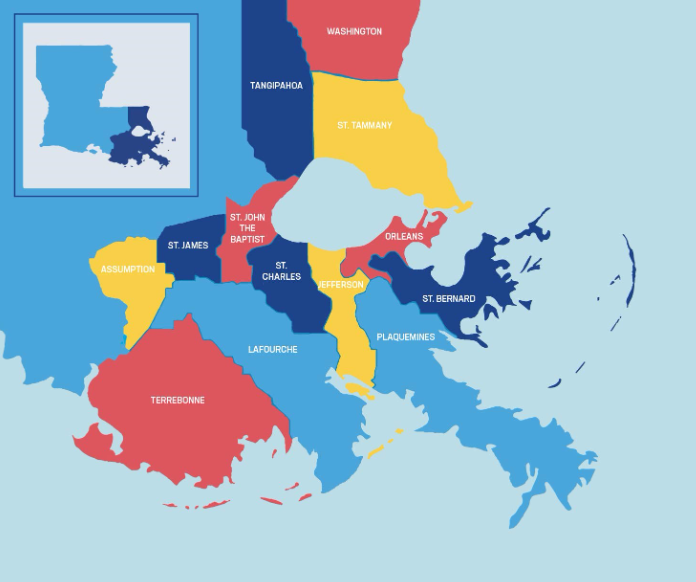





Millions of government dollars are available to support physical infrastructure, disaster recovery, and hazard mitigation projects. To date, disadvantaged communities throughout Southeast Louisiana have yet to fully benefit from this funding.
The Next 100 Years Challenge team understands that a range of technical assistance and support is essential for organizations that may not have the resources or capacity to engage stakeholders, prepare and develop a project, and navigate the many complexities of securing government funding.
To help level the playing field, the Next 100 Years Challenge offers guidance and technical assistance to potential applicants willing to conceive ambitious project-based proposals for infrastructure improvement in our region.
Proposed projects submitted to the Next 100 Years Challenge must demonstrate community buy-in, commitment from local leadership, and projected impact and a wide range of benefits to under-resourced, disadvantaged populations located in the thirteen parishes in the Southeast Louisiana region.
Here are tools to help identify and collect the required information on vulnerable, disadvantaged, underserved populations that will benefit from your project.
At a minimum, applications must include information demonstrating the team/project meets the following quantitative, technical criteria:
2023 Coastal Master Plan: The 2023 DRAFT Coastal Master Plan builds upon previous master plan efforts and strives to ensure that the collective effects of project investments reduce storm surge-based flood risk to communities, provide habitats to support an array of commercial and recreational activities, and support infrastructure critical to the working coast.
Benefit-cost analysis (BCA): Projects must conduct a BCA to be eligible for federal grants. The Next 100 Years Challenge award funds may be used to complete this requirement.
Building Resilience Through Plan Integration: This shares work around the Plan Integration for Resilience Scorecard (PIRS) with planners to help them ensure their communities' plans are consistent and aligned.
The Climate Explorer: Explore how climate is projected to change in any county in the United States.
FEMA Enhanced State Validation Toolkit: FEMA released this toolkit to support states in their sustained commitment to hazard mitigation.
FEMA Hazard Mitigation Best Practices: FEMA shares stories, articles or case studies about individuals, businesses or communities that undertook successful efforts to reduce or eliminate disaster risks.
FEMA Implementation Planning, Implementation, Long-term Maintenance & Operations: FEMA shares tools and publications to help communities integrate principles of hazard mitigation with planning efforts.
Hurricane Ida Disaster Response Evaluation Report: Hurricane Ida had a devastating impact on Southeast Louisiana. In partnership with nonprofits and generous donors, Greater New Orleans Foundation responded swiftly and powerfully. We share stories of our response here, knowing that our region is not alone in facing weather disasters. On our site, you can view videos and read profiles of our nonprofit partners, learn about our process, and dive deeper into our more formal evaluation report.
Louisiana’s Strategic Adaptations for Future Environments: LA Safe’s Regional Adaptation Strategy summarizes goals and action items developed through LA SAFE’s planning effort for implementation across a larger geography over a 50-year time frame.
Parcel number map: Some teams will provide parcel numbers if acquisitions are required. Regrid.com is dedicated to putting America online parcel by parcel. The Next 100 Years Challenge award funds may be used to complete this requirement.
Parish Plans: As part of the application, teams are asked to indicate how their proposed project aligns with existing parish plans, hazard mitigation plans, and other development plans, including existing recovery efforts underway.

State Climate Summary – Louisiana: These 2022 NOAA State Climate Summaries provide more up-to-date information on observed changes in climate, including both long-term trends and extreme weather events relevant to that state.
U.S. Climate Resilience Toolkit: Access national climate assessment reports, case studies, and other tools more to help meet the challenges of a changing climate. Learn more about potential climate hazards and how you can protect your vulnerable assets.
Acquisition: The acquiring by contract with appropriated funds of supplies or services (including construction) by and for the use of the Federal Government through purchase or lease, whether the supplies or services are already in existence or must be created, developed, demonstrated, and evaluated.
Green infrastructure: The range of measures that use plant or soil systems, permeable pavement or other permeable surfaces or substrates, stormwater harvest and reuse, or landscaping to store, infiltrate, or evapotranspirate stormwater and reduce flows to sewer systems or to surface waters.
Level of protection: The recurrence interval (such as a flood frequency risk) or physical extent to which a mitigation project offers protection.
Low-to-Moderate Income (LMI): People who have low-to-moderate income do not have more than the “moderate income” level (80% Area Median Family Income) set by the federal government for HUD (Housing & Urban Development)-assisted housing programs. This income standard changes from year to year and varies by household size, county/parish, and the metropolitan statistical area.
Nature-based solutions: Sustainable environmental management practices that restore, mimic, and/or enhance nature and natural systems; processes and supports natural hazard risk mitigation and economic, environmental, and social resilience efforts
Non-federal cost share: A cost share is required for all sub-applications funded under BRIC. The non-federal cost share funding may consist of cash, donated or third-party in-kind services and materials, or any combination thereof. FEMA will provide 100% of the federal funding for management costs. Cost share for BRIC is 75% federal cost share funding/25% non-federal cost share funding. Community Development Block Grant Program (CDBG) funding can be included as part of the cost share.
Physical infrastructure: The adequate engineering of fixed installations or physical components of the built environment, to be developed to withstand storms and other natural disasters of a predetermined or predictable magnitude
Pre-calculated benefits: A benefit value that has been calculated based on research and statistical analysis or computer modeling of mitigation projects.
Social vulnerability index: Database that helps to identify, map, and plan support for communities that will most likely need support before, during, and after a public health emergency, indicating the relative vulnerability of every U.S. county and tract